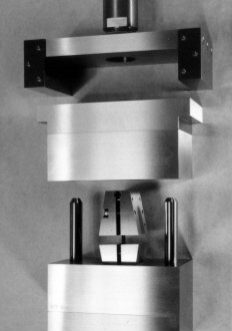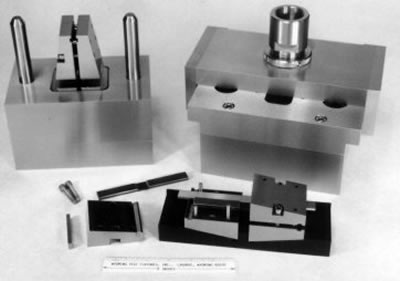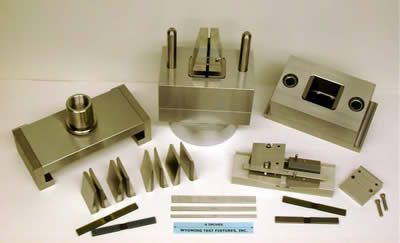IITRI Compression Test Fixture (ASTM D3410)
Model No. WTF-II (Stainless Steel)

Fig. 1: Exploded View of IITRI Compression Test Fixture.
The IITRI Compression Test Fixture, introduced by the Illinois Institute of Technology Research Institute (IITRI) in 1977 (Reference 1), became part of ASTM Standard D3410 in 1987 (Reference 2). The IITRI test fixture configuration incorporates flat wedge grips, as shown in Fig. 1, which make full surface contact with the mating blocks, independent of the tabbed specimen thickness.
Alignment rods in linear bearings are used, rather than an external alignment sleeve as in the Celanese Compression test fixture. This minimizes frictional binding between the fixture halves.
The Wyoming Test Fixtures, Inc. version, shown in Fig. 1, includes an upper bracket attached via an adapter to the crosshead of the testing machine. This permits easy slip-in installation and removal of the heavy upper block. The lower block normally rests freely on the base of the testing machine.
The Wyoming Test Fixtures, Inc. version of the IITRI Compression Test Fixture is designed to accommodate tabbed specimens up to 5.5" long, and of any width up to 1.5", as specified by the ASTM standard. For example, the fixture can accommodate a Celanese specimen, which is also 5.5" long, but only 0.25" wide.
The Wyoming Test Fixtures, Inc. version of the IITRI fixture is supplied with three sets of wedge-shaped spacers, which can be interchangeably inserted in the cavities of the upper and lower blocks, to accommodate tabbed specimens of a wide range of thicknesses. The approximate thickness ranges are (assuming the wedges are flush with the blocks when at the lower end of each range, and protruding a maximum of 0.50" at the upper end of each range): Low Range: 0.17"-0.35"; Medium Range: 0.29"-0.47"; High Range: 0.42"-0.60". That is, each set of spacers provides a tabbed specimen thickness range of about 0.18", with an approximately 0.05" overlap between ranges.
The standard gage length (distance between specimen tabs) per ASTM Standard D3410 is 0.50". The fixture can be used to test nonstandard gage length specimens also, from zero to approximately 2". (With longer alignment rods, specimens of even longer gage lengths can be used.)
The Wyoming Test Fixtures, Inc. version of the IITRI fixture also includes a specimen installation jig, shown in Fig. 2, with centering bars for four different specimen widths.

Fig. 2: Partially disassembled fixture, with an extra set of wedge grips shown mounted in the specimen installation jig and spacer bar in place.
A mostly disassembled IITRI compression test fixture is shown in Fig. 3. One set of wedge spacers is installed in the fixture blocks. The other two sets are shown at the lower left. One set of wedge grips is in the base block, which is resting on a 6" diameter fixed platen. An optional second set of wedge grips and one of the specimen alignment spacer bars is shown with the specimen alignment jig. The other three spacer bars are at the lower center of the photo. The four black strips are standard size, tabbed test specimens.

Fig. 3 Disassembled IITRI Compression Test Fixture
All accessory parts for each fixture are supplied in a foam-lined, wooden storage case, fitted with brass hinges, latch, and side handles. This provides an attractive and protective storage case for the various accessories when the fixture is not in use.
Sources of Additional Information:
1) Hofer, K.E., Jr. and Rao, P.N., "A New Static Compression Fixture for Advanced Composite Materials," Journal of Testing and Evaluation, Vol. 5, No. 4, July 1977, pp. 278-283.
2) ASTM Standard D 3410-03 (reapproved 2008), "Compressive Properties of Polymer Matrix Composite Materials with Unsupported Gage Section by Shear Loading," American Society for Testing and Materials, West Conshohocken, PA (first published in 1975).
3) D.F. Adams, "Current Status of Compression Testing of Composite Materials," Proceedings of the 40th International SAMPE Symposium, Anaheim, California, May 1995, pp. 1831-1843.
4) D.F. Adams and E.M. Odom, "Influence of Test Fixture Configuration on the Measured Compressive Strength of a Composite Material," Journal of Composites Technology and Research, Vol. 13, No. 1, Spring 1991, pp. 36-40.
5) J.S. Berg and D.F. Adams, "An Evaluation of Composite Material Compression Test Methods,"Journal of Composites Technology and Research, Vol. 11, No. 2, Summer 1989, pp. 41-46.
6) J.S. Welsh and D.F. Adams, “Current Status of Compression Test Methods for Composite Materials,“ SAMPE Journal, Vol. 33, No. 1, January 1997, pp. 35-43.

